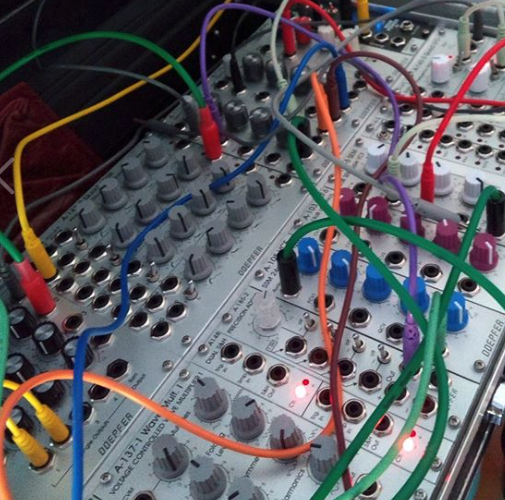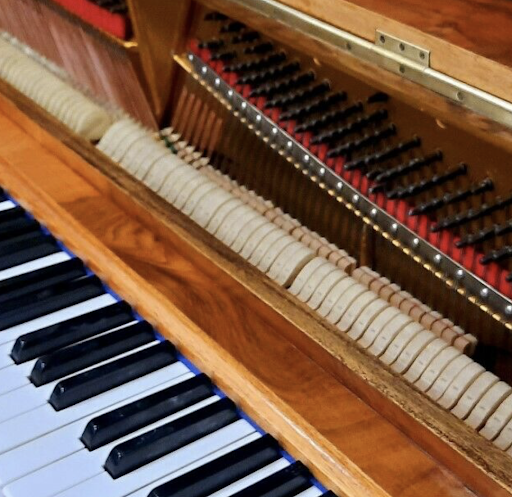Creating the Sounds for The Garden
The idea within the music was to create the feeling of the wings’
movement. The energy behind flight for a bird. I want the listener to have
the feeling of flying. I want to convey the feeling I get when geese fly
overhead. The energy and effort that the body exerts. Each wing
forcing the air while the body makes gentle sounds like an accordion. I
have ignored many aspects of time and tempo. Inspired by Erik Satie, I have ignored and eliminated the bar lines. There is no strict tempo, no pulse, no
defined time signature.
The birds sing all together but have little time or inclination to listen to each other much, as they are all too busy shouting for their own space in the world. The dawn chorus is a melee of songs and rhythms from all our garden birds. Some have flown hundreds of miles to be with us. Others are our native garden friends like the Blackbirds and the Robins.
There is no real time signature in this piece. It is all Tempo Rubato, with no end. Just the same way a bird would sing. The phrases are sometimes short and sometimes long. Some parts are in 12/8, others in 3/4, some are 9/8 and 4/4 or 5/4. All together they make a polyrhythm reflecting the birds at the dawn chorus. As no one teaches the birds time signatures or key relationships, they just sing over each other, repeating themselves.
I followed in the footsteps of Erik Satie by ignoring bar lines and conventions of time too. Nothing really has a time signature in the piece. Everything individually has one, but overall it is a chaos of polyrhythms. This is again deliberate, as I wanted to simulate the growing of the dawn into the light and then evaporating away like a dream. Also birds have no sense of time signatures when they sing together, they just sing. I didn’t want a set rhythm or time to the piece because birds don’t sing to a set pulse, nor are they conducted in any way to be together musically. Despite this, it is a beautiful wonder of nature. They are not thinking about 4/4 or 6/8, they just belt it out. The melee of music that is the dawn chorus is everyone singing all the favourite melodies at once. All the varied rhythms and lengths, everything predefined by what the birds can utter. But all as
one too.
I wanted to recreate musically the sound of birds flying. The effort and strain they exert for each moment of flight. Along with the feeling of oneness too.
The birds sing all together but have little time or inclination to listen to each other much, as they are all too busy shouting for their own space in the world. The dawn chorus is a melee of songs and rhythms from all our garden birds. Some have flown hundreds of miles to be with us. Others are our native garden friends like the Blackbirds and the Robins.
There is no real time signature in this piece. It is all Tempo Rubato, with no end. Just the same way a bird would sing. The phrases are sometimes short and sometimes long. Some parts are in 12/8, others in 3/4, some are 9/8 and 4/4 or 5/4. All together they make a polyrhythm reflecting the birds at the dawn chorus. As no one teaches the birds time signatures or key relationships, they just sing over each other, repeating themselves.
I followed in the footsteps of Erik Satie by ignoring bar lines and conventions of time too. Nothing really has a time signature in the piece. Everything individually has one, but overall it is a chaos of polyrhythms. This is again deliberate, as I wanted to simulate the growing of the dawn into the light and then evaporating away like a dream. Also birds have no sense of time signatures when they sing together, they just sing. I didn’t want a set rhythm or time to the piece because birds don’t sing to a set pulse, nor are they conducted in any way to be together musically. Despite this, it is a beautiful wonder of nature. They are not thinking about 4/4 or 6/8, they just belt it out. The melee of music that is the dawn chorus is everyone singing all the favourite melodies at once. All the varied rhythms and lengths, everything predefined by what the birds can utter. But all as
one too.
I wanted to recreate musically the sound of birds flying. The effort and strain they exert for each moment of flight. Along with the feeling of oneness too.

Once I had decided upon the structure and how I would create my ideas, I used Reaper as an audio recorder to record all my live takes using these instruments.
The Roland Juno 60 has a beautiful warm filter and oscillator which helped to create the polyphonic swells. Which I felt was very similar to this movement.
Noise was the starting point for the wing sounds. Just Red and Blue noise, filtered, modulated and shaped in various ways. The sounds of wings is incredibly hard to recreate, as it isn’t just the sound of the wings’ movement in the air, it is the compression and expansion of space. The wing sounds were made using the Synth AKS and a Doepfer eurorack modular synthesiser.
The EMS Synthi AKS was loaned by Ian Campbell at www.synthcurious.com, he also added some fine touches to these sounds himself for the big wing sounds. The Doepfer modular I built myself from eurorack modules and used a suitcase.

Everything in this piece was played live and recorded live. Nothing was sequenced or used MIDI. It was all played within the first two takes. I didn’t want to be too fussy about things, I like to get sounds down as they are, effects and all. I know this isn’t best practice for recording but it catches everything I want to, as too much studio trickery is not what I want in my music. I want it to feel alive and it to breathe, like the birds. I press record and play. I don’t like to edit or spend ages on each take.
The Vermona Perfourmer and the Analogue Solutions Telemark were used to create a mixture of sounds to aid the feeling of space and movement. These were recorded straight out to the line input on the audio interface. I didn’t do much processing in the digital domain as I prefer to do everything as analog as possible. Although it is a digital recorder, I didn’t do all the non-linear editing one might associate with software these days.

The Korg Delta is a lovely sounding string synth from the 80s, used by Human League, Bitch Cassidy, Flock of Seagulls, Ladytron, Zensor and Broadcast. Very much a hands on player synth, with beautiful modulation and poly pitch temperament. This was recorded through a ElectroHarmonix Memory man guitar pedal, as the delay is so good. All effect went onto the same track too.
The piano melodies were recorded with a pair of SE electronic Condenser microphones. This is the only track that was really messed about with. By this, I mean it sounds as if it doesn’t sound like a piano due to it being reversed. Each set of 4 chords have been recorded and looped to create 12 groups of four chords. The Eø7 chord was where the whole piece started from. One of John Lennon’s favourite chords too. Very ambiguous in harmonic terms due to the diminished 5th. Can also be written and through ion as a Gm6 too. So a vague and unsettled perch in music. The ø7 chord is used in much eastern music too.
No pitch correct or anything like that – I didn’t even edit the takes much, once recorded. This was because the original recording was played how I wanted it to be, even the fades. So everything is live. I just played and enjoyed the synths through good speakers. A small amount of compression using Focusrite Red Series was used here and there, just to tame some of the highs and keep the bass frequencies in line. A little EQ again using the Focusrite Red plug ins for this. This was only to make things sit in the mix a little better. Sometimes things need a little help sitting in the ‘zone’ a little. But nothing was used to really destroy or shape sounds in any way. The sounds are the synths as they are, with me messing about with them live. No MIDI or any form of sequencing was used in making any of this music as I prefer to work entirely live. This is why I prefer the analog synth as they usually don’t use midi or any presets. This can all be done on software too and very well these days, but I have given up on software synths on the whole.


Thank you for listening and reading the work produced for The Garden.
